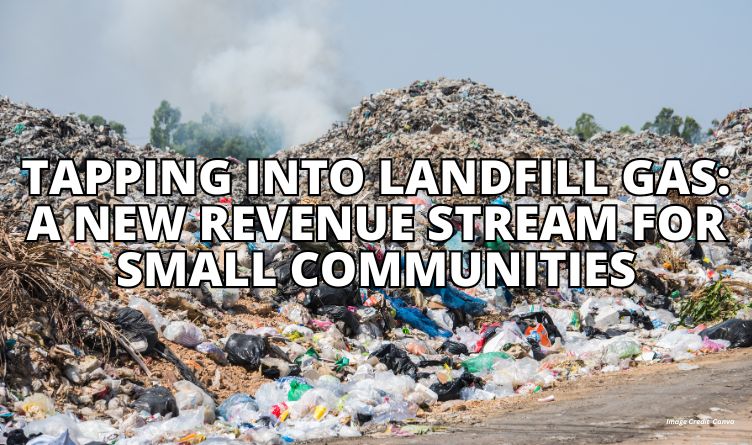Image Credit: Canva
Submitted by Rob Mitchell [Rutherford County Assessor of Property] –
In an era of tight budgets and environmental concerns, innovative local officials are exploring untapped resources to benefit their communities. Our office, the Property Assessor for Rutherford County, Tennessee, along with assessor’s in other major Tennessee counties have been investigating the potential of landfill natural gas (LFG) as a valuable mineral right and revenue source for small, cash-strapped communities.
The Hidden Value in Landfills
Landfills, often seen as necessary burdens for communities, may hold a surprising economic opportunity. As organic waste decomposes, it produces methane – a potent greenhouse gas that can be captured and used as a renewable energy source. This landfill gas, when properly harnessed, can be converted into electricity or refined into renewable natural gas (RNG) for various applications.
Many communities, especially smaller ones, have been grappling with the long-term consequences of past solid waste decisions and by recognizing LFG as a valuable mineral right, we can potentially turn these environmental liabilities into assets.
Assessing LFG as a Mineral Interest
This groundbreaking approach involves treating LFG as a mineral interest, similar to how oil, gas, or coal reserves are assessed. This classification allows for the valuation and taxation of LFG production, potentially creating a new revenue stream for local governments.
Key components of the proposed assessment framework include:
- Registration of LFG mineral interests with county property assessors
- Valuation based primarily on the income approach, considering factors such as:
- Estimated LFG production volume. ( Rutherford County’s landfill is estimated to produce over 2 billion cu/ft per year).
- Methane content (typically 50-55% of LFG).
- Energy generation potential.
- Local market demand for LFG-derived products.
- Classification of LFG interests as active, depleted, or inactive mineral reserves
- Consideration of environmental benefits, including greenhouse gas reduction and potential carbon credits or government subsidies ( which may contribute to value).
Opportunities for Small Communities
For small communities burdened with landfills, this approach offers several potential benefits:
- New Revenue Source: By assessing and taxing LFG as a mineral interest, communities can generate additional income from existing landfills. Some may have mineral severance taxes as an added bonus.
- Environmental Improvement: Encouraging LFG capture and utilization reduces methane emissions, contributing to climate change mitigation efforts.
- Energy Independence: LFG can be used to generate electricity or produce RNG, potentially reducing a community’s reliance on external energy sources.
- Economic Development: LFG projects can create local jobs and attract investment in green energy infrastructure.
Challenges and Considerations
While promising, the assessment of LFG as a mineral interest is not without challenges. Implementing this approach requires careful navigation of existing laws and regulations.
We’re working closely with state officials and environmental agencies to ensure our assessment methods align with current statutes and environmental standards. It’s a complex process, but the potential benefits for our communities make it worth pursuing.
Looking Ahead
As we refine our approach and build support for LFG assessment, other communities across Tennessee and beyond are taking notice. This innovative strategy could provide a model for other regions looking to maximize the value of their landfills while addressing environmental concerns.
Our goal is to create a win-win situation. By recognizing the value of LFG, we can help our communities recover from past waste management decisions while contributing to a more sustainable future.
As local governments continue to face financial pressures and environmental challenges, innovative approaches like the LFG assessment strategy may offer a glimmer of hope – turning yesterday’s waste into tomorrow’s resource.
======================================================
Proposed Policy Guidelines for the Assessment of Landfill Natural Gas (LFG) Mineral Interests in Tennessee
Purpose
This policy establishes a structured process for assessing landfill gas (LFG) as a mineral interest at solid waste landfills in Tennessee. It incorporates state statutory requirements, including T.C.A. § 67-5-804, and guidelines from the State Board of Equalization to ensure compliance and consistency in valuation.
Scope
The policy applies to all solid waste landfills in Tennessee producing or potentially producing LFG, ensuring compliance with the registration, valuation, and reporting requirements for mineral interests.
Framework for Assessing Landfill Natural Gas Mineral Interests
1. Registration Requirement
In compliance with T.C.A. § 67-5-804 and State Board of Equalization guidelines:
- Registration of Interests: Owners of LFG mineral interests must register with the county property assessor where the landfill is located.
- Information Required: Owners must provide:
- A deed reference number for the mineral interest.
- Specific location details, including tax maps and parcel numbers of surface owners.
- Methods of Identification: Mineral interest owners can identify their interests by:
- Providing map and parcel numbers of surface owners.
- Submitting accurate maps showing the location of the mineral interest.
- Providing surface owners’ names and additional information to pinpoint the interest.
- Exemption from Re-registration: Mineral interests properly registered and identified as of July 1, 1987, with taxes paid through that date, do not require further registration.
2. Valuation Approach
The income approach is the primary method for valuing LFG as a mineral interest due to the unique nature of LFG production:
- Income Approach: Calculate the potential income generated from LFG over the productive life of the landfill, typically during Phase IV (post-closure) when production stabilizes for around 20 years. This method reflects the income potential from methane capture and conversion into energy or renewable natural gas (RNG).
- Comparable Sales Approach: While less applicable for LFG, assessors should consult comparable LFG projects, adjusting for local market conditions where possible.
- Cost Approach: Consider the cost of infrastructure required to collect and process LFG, including installation and maintenance of gas collection system
Specific Valuation Guidelines
The State Board of Equalization provides specific guidelines for various mineral reserves, which should be adapted for LFG:
- Production Volume: Estimate LFG production volume based on landfill size, waste composition, and landfill age.
- Methane Content: Typically, methane comprises 50-55% of LFG by volume.
- Energy Potential: Assess the energy generation potential of methane for use in electricity production or conversion to RNG.
- Market Demand: Evaluate local and regional demand for LFG-derived products, including energy and RNG.
- Infrastructure: Consider the availability of LFG collection systems, processing facilities, and potential expansions.
Classification of Mineral Interests
Landfill gas mineral interests should be classified similarly to other mineral reserves:
- Active Mineral Reserves: LFG sites where gas is actively produced and utilized.
- Depleted Mineral Reserves: Landfills where gas production has ceased.
- Inactive Mineral Reserves: Landfills where LFG production is possible but not currently active or utilized.
Environmental Considerations
The valuation of LFG must consider the environmental benefits:
- Greenhouse Gas Reduction: Capture of LFG reduces methane emissions, contributing to climate change mitigation.
- Carbon Credits: Assess the potential value of carbon credits or other environmental incentives.
Technology Considerations
Assess the type and efficiency of LFG utilization technologies:
- Electricity Generation: Evaluate systems like internal combustion engines, gas turbines, and microturbines.
- Renewable Natural Gas (RNG): Assess the feasibility and market for converting LFG to RNG for distribution.
Reporting and Record Keeping
Per the guidelines of the State Board of Equalization:
- Reporting Requirements: Use State Board forms and questionnaires to gather necessary information for assessment, including production volumes, infrastructure, and market conditions.
- Record Keeping: Maintain detailed records for each parcel of taxable property with LFG mineral interests, ensuring separate valuations for surface and mineral interests. Assessors must track the development, production, and value of LFG over time.
Penalties for Non-Compliance
In accordance with T.C.A. § 67-5-804, penalties are imposed for failure to comply with registration and identification requirements:
- Back Assessment: Failure to register by the statutory deadline (July 1, 1990) subjects the property to back assessment or reassessment.
- Penalty for Non-registration: A 25% penalty on the assessment or back assessment of taxes will be imposed for non-registration.
- Penalty for Failure to Identify Mineral Interest: A 10% penalty is imposed for failure to properly identify the location of the mineral interest.
- Abandonment Claims: Failure to identify the location of a mineral interest prevents the owner from using tax payments as evidence against a surface owner’s claim of abandonment.
Assessment Process
1. Data Collection
- Collect comprehensive data on landfill characteristics, LFG production, infrastructure, and market conditions. Ensure that all mineral interests are properly registered and identified.
2. Valuation
- Apply the income approach and, where possible, the comparable sales approach, considering environmental and technological factors.
3. Review
- Periodically review LFG production, infrastructure, and market changes to update valuations as needed.
4. Appeals Process
- Establish a formal process for landfill operators or mineral interest owners to appeal assessments if they believe the valuation is inaccurate or penalties have been improperly applied.
Implementation
- Training: Assessors should receive ongoing training on LFG valuation methods, compliance with T.C.A. § 67-5-804, and State Board guidelines.
- Collaboration: Engage with environmental agencies and industry experts to ensure up-to-date information and best practices are applied.
- Policy Updates: Review and update this policy regularly to reflect changes in legislation, technology, and market conditions.



